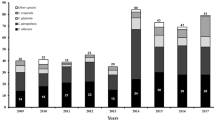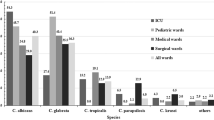Abstract
Purpose
The aim of this study was to assess the epidemiology of candidemia and antifungal susceptibility profiles of Candida isolates in Italy through a prospective surveillance study and to evaluate changes compared to a previous survey performed in one Italian region (Lombardy) in 1997–1999.
Methods
A prospective laboratory-based surveillance of candidemia was performed in Italy from January to December 2009. For each case a questionnaire was filled in, and the first isolate was collected and tested for in vitro antifungal susceptibility.
Results
During our 12-month survey, 467 episodes of candidemia were reported from 34 centres (30 located in Lombardy) and 464 isolates collected. Candida albicans was the predominant species (overall incidence 50.4 %), but the proportion varied considerably from 52.1 % in Lombardy hospitals to 45.2 % hospitals located outside this region. The second most frequent species was C. glabrata in Lombardy and C. parapsilosis in other regions. Comparison of the 1997–1999 and 2009 data on episodes of candidemia in Lombardy revealed a threefold increase in incidence (from 0.38 to 1.19 per 1,000 admissions), aging of infected patients, decline in crude mortality (from 35 to 27.1 %) and an increased proportion of C. glabrata etiology (from 12.8 to 20.3 %). Susceptibility testing confirmed the broad activity of amphotericin B and echinocandins. Decreased susceptibility to fluconazole was found in 24.9 % of the tested isolates.
Conclusions
The results of this latest survey confirm the high rate of candidemia in Italy and show changes in some of the epidemiological tracts, such as aging of infected patients, increased proportion of C. glabrata infections, increased diagnosis in medical wards, and improvement in patients’ survival.
Similar content being viewed by others
References
Blennow O, Tallstedt L, Hedquist B, Gårdlund B. Duration of treatment for candidemia and risk for late-onset ocular candidiasis. Infection. 2013;41:129–34. doi:10.1007/s15010-012-0369-8.
Ahlquist Cleveland A, Farley MM, Harrison LH, Stein B, Hollick R, Lockhart SR, Magill SS, Derado G, Park BJ, Chiller T. Changes in incidence and antifungal drug resistance in candidemia: results from population-based laboratory surveillance in Atlanta and Baltimore, 2008–2011. Clin Infect Dis. 2012;55:1352–61.
Arendrup MC, Bruun B, Christensen JJ, Fuursted K, Krogh Johansen H, Kjældgaard P, Knudsen JD, Kristensen L, Møller J, Nielsen L, Rosenvinge FS, Røder B, Schønheyder HC, Thomsen MK, Truberg K. National surveillance of fungemia in Denmark (2004 to 2009). J Clin Microbiol. 2011;49:325–34. doi:10.1128/JCM.01811-10.
Falagas ME, Roussos N, Vardakas KZ. Relative frequency of albicans and the various non-albicans Candida spp. among candidemia isolates from inpatients in various parts of the world: a systematic review. Int J Infect Dis. 2010;14:e954–66. doi:10.1016/j.ijid.2010.04.006.
Tortorano AM, Biraghi E, Astolfi A, Ossi C, Tejada M, Farina C, Perin S, Bonaccorso C, Cavanna C, Raballo A, Grossi A. European Confederation of Medical Mycology (ECMM) prospective survey ofcandidemia: report from one Italian region. J Hosp Infect. 2002;51:297–304. doi:10.1053/jhin.2002.1261.
Rodriguez-Tudela JL, Arendrup MC, Barchiesi F, Bille J, Chryssanthou E, Cuenca-Estrella M, Dannaoui E, Denning DW, Donnelly JP, Dromer F, Fegeler W, Lass-Florl C, Moore CB, Richardson M, Sandven P, Velegraki A, Verweij PE. EUCAST Definitive Document EDef 7.1: method for the determination of broth dilution MICs of antifungal agents for fermentative yeasts. Clin Microbiol Infect. 2008;14:398–405. doi:10.1111/j.1469-0691.2007.01935.x.
The European Committee on Antimicrobial Susceptibility Testing-Subcommittee on Antifungal Susceptibility Testing (EUCAST-AFST). EUCAST technical note on fluconazole. Clin Microbiol Infect. 2008;14:193–5. doi:10.1111/j.1469-0691.2007.01899.x.
Pfaller MA, Andes D, Diekema DJ, Espinel-Ingroff A, Sheehand D. Wild-type MIC distributions, epidemiological cut-off values and species-specific clinical breakpoints for fluconazole and Candida: time for harmonization of CLSI and EUCAST broth microdilution methods. Drug Resist Updat. 2010;13:180–95. doi:10.1016/j.drup.2010.09.002.
Pfaller MA, Diekema DJ, Andes D, Arendrup MC, Brown SD, Lockhart SR, Motyl M, Perlin DS, CLSI Subcommittee for Antifungal Testing. Clinical breakpoints for the echinocandins and Candida revisited: integration of molecular, clinical, and microbiological data to arrive at species-specific interpretive criteria. Drug Resist Updat. 2011;14:164–76. doi:10.1016/j.drup.2011.01.004.
Clinical and Laboratory Standards Institute (CLSI). Reference method for broth dilution antifungal susceptibility testing of yeasts. 3rd ed. Document M27–A3. Wayne: Clinical and Laboratory Standards Institute; 2008.
Ramage G, vande Walle K, Wickes BL, Lopez-Ribot JL. Standardized method for in vitro antifungal susceptibility testing of Candida albicans biofilms. Antimicrob Agents Chemother. 2001;45:2475–9. doi:10.1128/AAC.45.9.2475-2479.2001.
Diekema D, Arbefeville S, Boyken L, Kroeger J, Pfaller M. The changing epidemiology of healthcare-associated candidemia over three decades. Diagn Microbiol Infect Dis. 2012;73:45–8. doi:10.1016/j.diagmicrobio.2012.02.001.
Pfaller MA, Diekema DJ. Epidemiology of invasive candidiasis: a persistent public health problem. Clin Microbiol Rev. 2007;20:133–63. doi:10.1128/CMR.00029-06.
Presterl E, Daxböck F, Graninger W, Willinger B. Changing pattern of candidaemia 2001–2006 and use of antifungal therapy at the University Hospital of Vienna, Austria. Clin Microbiol Infect. 2007;13:1072–6. doi:10.1111/j.1469-0691.2007.01812.
Arendrup MC, Fuursted K, Gahrn-Hansen B, Schønheyder HC, Knudsen JD, Jensen IM, Bruun B, Christensen JJ, Johansen HK. Semi-national surveillance of fungaemia in Denmark 2004–2006: increasing incidence of fungaemia and numbers of isolates with reduced azole susceptibility. Clin Microb Infect. 2008;14:487–94. doi:10.1111/j.1469-0691.2008.01954.x.
Lortholary O, Desnos-Ollivier M, Sitbon K, Fontanet A, Bretagne S, Dromer F, French Mycosis Study Group. Recent exposure to caspofungin or fluconazole influences the epidemiology of candidemia: a prospective multicenter study involving 2,441 patients. Antimicrob Agents Chemother. 2011;55:532–8. doi:10.1128/AAC.01128-10.
Malani AN, Psarros G, Malani PN, Kauffman CA. Is age a risk factor for Candida glabrata colonisation? Mycoses. 2011;54:531–7. doi:10.1111/j.1439-0507.2010.01941.
Marchetti O, Bille J, Fluckiger U, Eggimann P, Ruef C, Garbino J, Calandra T, Glauser MP, Täuber MG, Pittet D, Fungal Infection Network of Switzerland (FUNGINOS). Epidemiology of candidemia in Swiss tertiary care hospitals: secular trends, 1991–2000. Clin Infect Dis. 2004;38:311–20. doi:10.1086/380637.
von Borg-Zepelin M, Kunz L, Ruchel R, Reichard U, Weig M, Groß U. Epidemiology and antifungal susceptibilities of Candida spp. to six antifungal agents: results from a surveillance study on fungaemia in Germany from July 2004 to August 2005. J Antimicrob Chemother. 2007;60:424–8. doi:10.1093/jac/dkm145.
Tortorano AM, Kibbler C, Peman J, Bernhardt H, Klingspor L, Grillot R. Candidaemia in Europe: epidemiology and resistance. Int J Antimicrob Agents. 2006;27:359–66. doi:10.1016/j.ijantimicag.2006.01.002.
Cisterna R, Ezpeleta G, Telleria O, Guinea J, Regueiro B, Garcia-Rodríguez J, Esperalba J, The Spanish Candidemia Surveillance Group. Nationwide sentinel surveillance of bloodstream Candida infections in 40 tertiary care hospitals in Spain. J Clinical Microbiol. 2010;48:4200–6. doi:10.1128/JCM.00920-10.
Bassetti M, Taramasso L, Nicco E, Molinari MP, Mussap M, Viscoli C. Epidemiology, species distribution, antifungal susceptibility and outcome of nosocomial candidemia in a tertiary care hospital in Italy. PLoS ONE. 2011;6:e24198. doi:10.1371/journal.pone.0024198.
Nucci M, Colombo AL. Candidemia due to Candida tropicalis: clinical, epidemiologic, and microbiologic characteristics of 188 episodes occurring in tertiary care hospitals. Diagn Microbiol Infect Dis. 2007;58:77–82. doi:10.1016/j.diagmicrobio.2006.11.009.
Prigitano A, Dho G, Lazzarini C, Ossi C, Cavanna C, Tortorano AM. Biofilm production by Candida isolates from a survey of invasive fungal infections in Italian intensive care units. J Chemother. 2012;24:61–3.
Acknowledgments
This study was supported, in part, by a grant from Astellas Pharma S.p.A., Italy. A. Prigitano received a research grant “Dote ricerca”: FSE, Regione Lombardia. The FIMUA candidemia working group includes also: M. Facchini, M. Longo, G. Viola, G. Giuliani, L. Mella, G. Marino, L. Ghirardelli, G. Balzano, L. Pradorio, F. Giglio, S. Acerno (Milan), A. Ceraminiello, O. Perugini (Lodi), D. Longo (Vimercate), E. Casari, R. Rosati, M. Montorsi (Rozzano), G. Munafò (Chiari-Iseo), P. Pedroni (Manerbio), C. Bezzi (Magenta), M. Tejada (S.Donato), M. Arghittu (Vizzolo), C. Bonetti (Crema), R. Sala (Desio), C. Sturla, C. Laudi (Gallarate), L. Re (Garbagnate), C. Agrappi (Legnano), M. Re (Rho), A. Grossi (Treviglio), G. Brigante (Lecco), G. Del Vecchio (Bergamo), R. Signori (Como), C. Cavanna (Pavia), L. Pitzurra (Perugia), G. Caggiano, T. Cuna (Bari), L. Trovato (Catania).
Conflict of interest
None.
Author information
Authors and Affiliations
Corresponding author
Additional information
On behalf of FIMUA candidemia working group.
Rights and permissions
About this article
Cite this article
Tortorano, A.M., Prigitano, A., Lazzarini, C. et al. A 1-year prospective survey of candidemia in Italy and changing epidemiology over one decade. Infection 41, 655–662 (2013). https://doi.org/10.1007/s15010-013-0455-6
Received:
Accepted:
Published:
Issue Date:
DOI: https://doi.org/10.1007/s15010-013-0455-6




